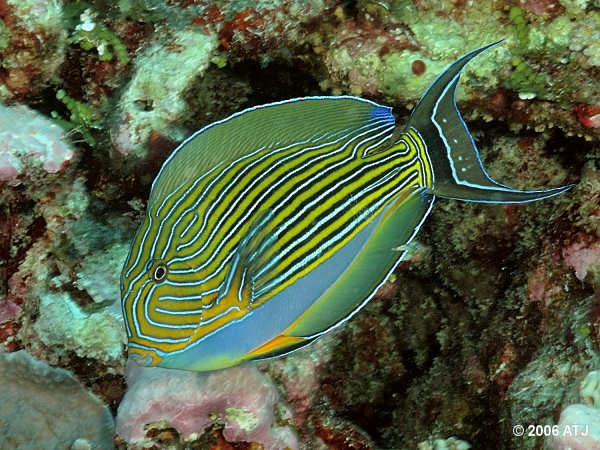
Acanthurus lineatus
FAMILY
Acanthuridae
TAXONOMY
Acanthurus lineatus Linnaeus, 1758, “Indies.” No type specimens
are known.
OTHER COMMON NAMES
French: Chirurgien zйbrй; German: Blaustreifen-Doktosfisch;
Japanese: Nijihagi.
PHYSICAL CHARACTERISTICS
The body is compressed and disc-like and possesses a large,
venomous, scalpel-like caudal spine on each side of the caudal
peduncle. The caudal fin is strongly lunate. There are nine
spines and 27–30 soft rays in the dorsal fin, three spines and
25–28 soft rays in the anal fin, and 16 soft rays in the pectoral
fin. Body coloration is striking and consists of a yellowish
green background, bright blue stripes (narrow and oblique on
the head) edged with black on the flank but lacking the black
edge on the head, and lavender blue to bluish white on the
belly. The pelvic fins are bright orange. The caudal fin has two
vertical lines of dark blue set against a background of purplish
gray, replaced by yellow at the base of the fin. The remaining
fins are purplish gray yielding to greenish yellow at the base.
Larvae are acronurus, in that they are orbicular in shape; transparent,
with a silvery sheen over the head, chest, and abdomen;
and scaleless and have narrow, vertically oriented ridges along
the body. (Acronurus refers to the last, well-developed but
seemingly different, post-larval stage of surgeonfishes in the
genera Acanthurus, Ctenochaetus, and Zebrasoma. Originally this
stage was proposed to be a separate genus of surgeonfishes until
closer examination revealed otherwise.) The second anal,
second dorsal, and pelvic spines are elongated and venomous.
Larvae are well adapted to the pelagic realm and may remain
there for more than 39 days. Adults may grow to 15 in (38 cm)
in length and can live for as long as 30–45 years.
DISTRIBUTION
Indo-West Pacific, from East Africa east to the Marquesas and
the Tuamotu Archipelago, north to southern Japan, and south
to New South Wales, Australia; strays rarely to the Hawaiian
Islands. Replaced by the very similar species A. sohal in the
vicinity of the Arabian Peninsula (Red Sea and Persian Gulf).
HABITAT
Usually found on exposed reef fronts at depths of 3.3–9.8 ft
(1–3 m).
BEHAVIOR
Highly territorial. Patrols territories along the reef front and
aggressively attacks conspecifics, other surgeonfishes, and other
herbivores. Temporarily assumes a darker coloration of the
head during territorial displays and encounters. Wields its caudal
spines as effective weapons against attack.
FEEDING ECOLOGY AND DIET
Herbivorous. Browses on filamentous and fleshy algae using
specialized teeth.
REPRODUCTIVE BIOLOGY
Migrates to and spawns in aggregations at specific sites, although
it sometimes spawns in pairs. Reported to spawn in
early morning during the first 1–3 hours of a falling tide just
before the full moon. Has been observed spawning at sunset as
well. Tidal state, rather than time of day, more likely accounts
for the temporal pattern of spawning. Spawning occurs yearround
at lower latitudes but may be seasonal at higher latitudes.
Eggs and larvae are pelagic.
CONSERVATION STATUS
Not listed by the IUCN.
SIGNIFICANCE TO HUMANS
An important species in subsistence and artisanal food fisheries.
Also collected for larger aquaria.
Photo Gallery of - Lined surgeonfish

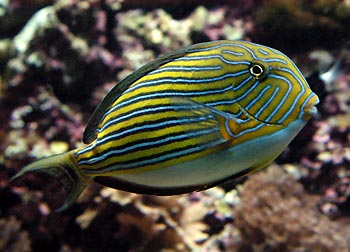
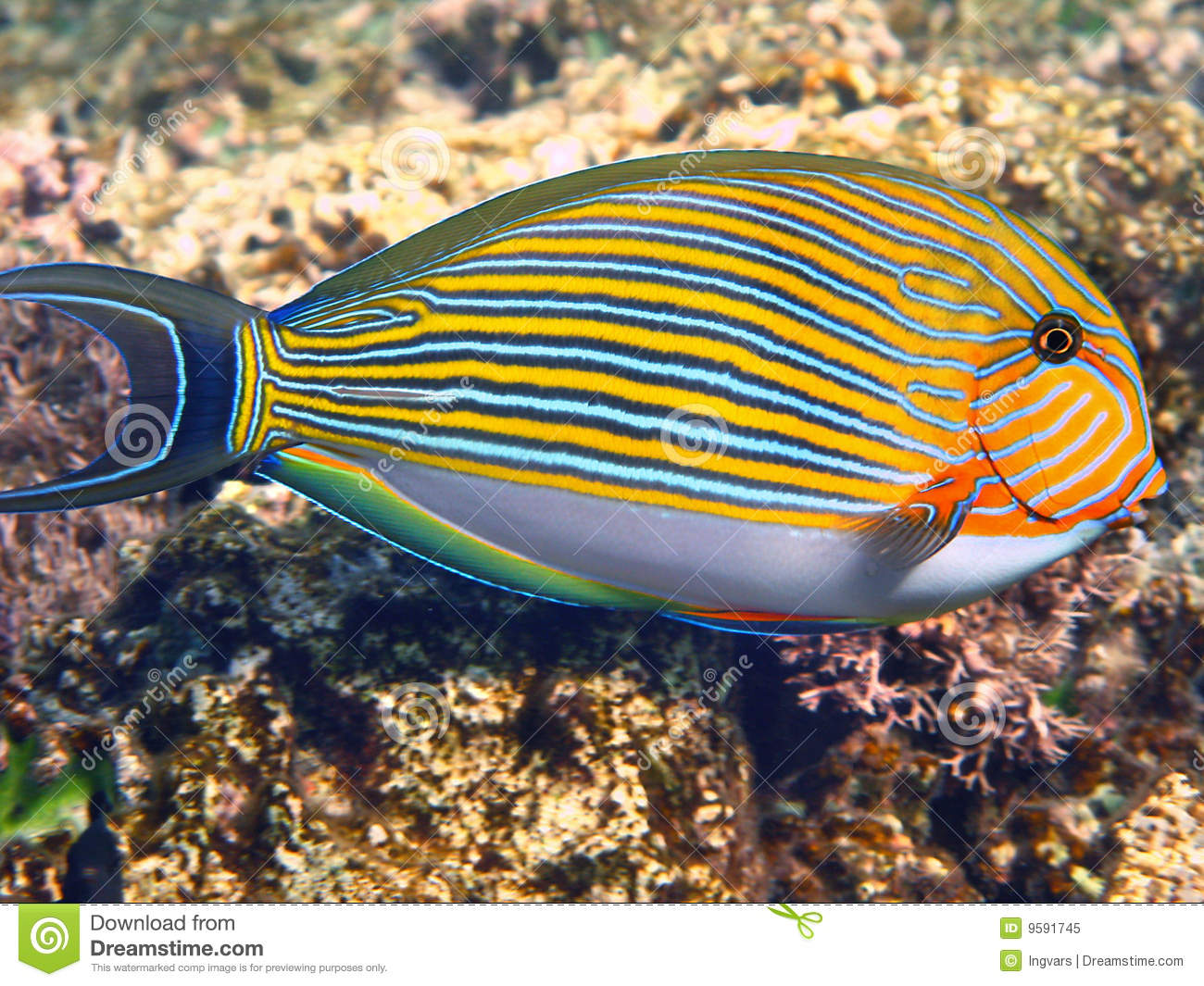
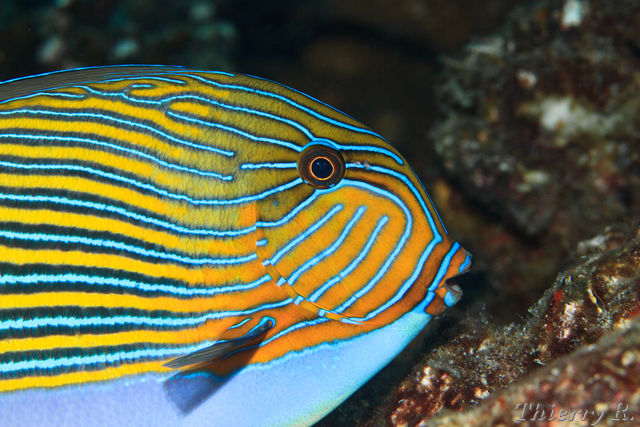
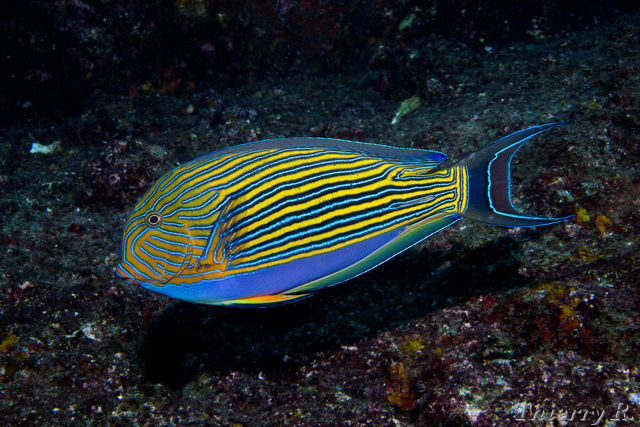
 Animalia Life
Animalia Life